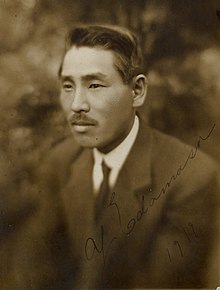Yoshiro Edamasa
Yoshiro Edamasa 枝正 義郎 | |
|---|---|
 Edamasa in 1919 | |
| Born | September 22, 1888 Kujima Village, Hiroshima Prefecture, Japan |
| Died | September 8, 1944 (aged 55) |
| Nationality | Japanese |
| Occupation | Film director |
| Years active | 1914-1934 |
Yoshiro Edamasa (枝正 義郎, Edamasa Yoshirō, 22 September 1888 – 8 September 1944) was a Japanese film director best known for and The Great Buddha Arrival.[1] He was an early pioneer of Japanese cinema who trained many outstanding directors and cinematographers including Eiji Tsuburaya.[2]
Edamasa worked in the film industry from 1910, when he was hired by Yoshizawa Shōten. He later worked as an operator also for and .[3]
He made his debut as a director in 1919 on the film Ai no kyoku which was considered to be one of the most advanced films of that time.[4] By the end of the 1930s, Edamasa had directed more than 20 films.[3]
Edamasa belonged to a group of directors who emphasized the realistic style of acting.[5]
Biography[]
Edamasa was born in Kujima Village, Saeki District, Hiroshima Prefecture (currently Kujima, Hatsukaichi City)[6] his Educational background is unknown. Tokyo to 1908 (1908) First is said to have embarked on the box office movie in Japan Yoshizawa shop ( Nikkatsu entered into one of the predecessor of), Meguro Yukito hill in the studio Kichizo Chiba studied under, pulled out the ironing developing and Learn shooting techniques. There is also a theory that he has been instructed at the Meguro studio since he was a boy.[6] Then, Fukutakarado (one of the predecessor of the Nikkatsu), Toyo Shokai he moved with Taisho three years ( 1914 ),[6] the new company, was born by the two companies merger natural color activities photo imaging technician turned to the corporation (Tenkatsu) to become.[7]
Selected filmography[]
- Yoshitsune sembon zakura[8] (1914) - Cinematographer
- (1918) - Cinematographer[8]
- (1918) - Cinematographer[8]
- (1919) - Director and Cinematographer[citation needed]
- (1919) - Director[8]
- (1920) - Director[8]
- (1924) - Director[citation needed]
- [8] (1924) - Director[8]
- [8](1928) - Director[6][8]
- (1929) - Director[citation needed]
- [8] (1929) - Director
- [8] (1932) - Director
- The Great Buddha Arrival (1934)[7] - Director (Last work)[7][6]
References[]
- ^ "Films directed by Yoshiro Edamasa". letterboxd.com. Retrieved 2020-12-07.
- ^ Yamamoto, Akira (1982). Hiroshima Encyclopedia (1). Chugoku Shimbun. p. 147.
- ^ Jump up to: a b Komatsu, Hiroshi; Abel, Richard (2005). Encyclopedia of Early Cinema. London: Routledge. ISBN 0-415-23440-9.
- ^ Lee, Daw-Ming (2012). Historical Dictionary of Taiwan Cinema. Scarecrow Press. p. 37. ISBN 978-0-8108-7922-5.
- ^ "Początki kina w Japonii – multimedialny wykład dra Jakuba Karpoluka". www.iluzjon.fn.org.pl. Retrieved 2021-07-13.
- ^ Jump up to: a b c d e "枝正義郎", Wikipedia (in Japanese), 2019-10-18, retrieved 2020-12-07
- ^ Jump up to: a b c "Godzilla-Italia - Scheda Regista: Yoshiro Edamasa". www.fantaclassici.com. Retrieved 2020-12-07.
- ^ Jump up to: a b c d e f g h i j k "Yoshiro Edamasa". IMDb. Retrieved 2020-12-07.
External links[]
- Japanese film director stubs
- 1888 births
- Japanese film directors
- 1944 deaths